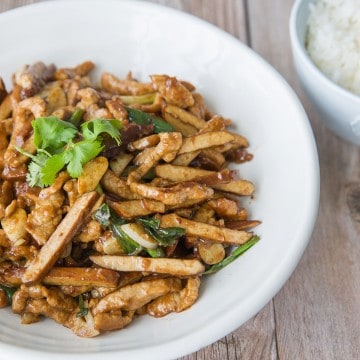
One of my favorite appetizers when dining at Japanese restaurants is Agedashi Tofu. I can't resist the soft, silky tofu with a light, crispy outer shell, swimming in a sweet and savory umami-rich sauce, called Tsuyu Sauce. On the days when I’m craving something light, I turn to Agedashi Tofu as my main course. It's packed with protein to keep me full without weighing me down.
What Type of Tofu Works Best for Agedashi Tofu?
For this Agedashi Tofu recipe, we prefer to use soft tofu for the texture. There's a great contrast between the soft tofu and crispy outer shell. Just be sure to handle it with gentle hands since soft tofu breaks apart quite easily. For something less delicate and easier to handle, medium-firm tofu works just as well. The texture is firmer and "meatier."
Another alternative is silken tofu, which is actually my favorite option to use for Agedashi Tofu. Like the name suggests, its silky texture is delicate and so delicious when fried. However, although it is my favorite, I don't often use it because silken tofu is so delicate, it requires great care. Even the slightest pressure will break the tofu.
What is Tsuyu Sauce and How to Make it
Tsuyu sauce is a light soy sauce based condiment commonly in Japanese cuisine. It has a slight sweetness to it with tons of umami from the dashi stock. Its versatility is apparent in its myriad applications. It can be served hot or cold as well as diluted or full strength. It's often used with Japanese noodles for dipping or diluted as a soup base. It's also used as a dipping sauce for tempura or simmered with meat and/or vegetables. Tsuyu sauce can be purchased online; however, I highly recommend making your own.
Tsuyu sauce begins with a good dashi stock. Homemade is recommended but in a pinch, powdered HonDashi will work as well. To the dashi stock, add light and dark soy sauce, mirin and sugar. Simmer the sauce until it's reduced by a third so that a cup of sauce remains. For this Agedashi Tofu recipe, keep it covered and warm on low on a back burner until it's needed. Any leftover Tsuyu sauce can be stored in the fridge for up to one month. Or make extra sauce for other delicious Japanese recipes such as Yoshinoya-Style Gyudon.
Tips for Frying Agedashi Tofu
Deep frying at home isn’t always the most ideal way to cook. It can get messy and you're left with a pot of hot oil to deal with afterwards. I try to avoid deep frying at home as much as possible. Fortunately, this Agedashi Tofu recipe works just as well shallow fried. I still use a pot to contain splatters, but I only add about an inch of oil, just enough so that the tofu is half submerged in oil.
Before frying, we need to prep the tofu by removing as much moisture as possible. Lay the block of tofu on a few paper towels and put a few more sheets on top. Rest a plate on top of the tofu with something heavy to weigh it down. A couple cans of vegetables usually does the trick. Let the tofu drain for 15-20 minutes.
When the oil is ready for frying, dry the tofu cubes with fresh paper towels. One at a time, dredge the tofu on all sides in potato starch and gently dust off the excess. We only want a light coating. It's very important that the dredged tofu cubes are fried right away. Even after draining, tofu remains very moist and if it sits after it's been dredged, the coating will become wet and gummy. Once it reaches this state, it won't yield the crispy outer shell we're looking for.
Last but not least, fry the tofu in small batches so you don't overcrowd the pot and bring down the temperature of the oil.
Ingredients
- 1 16 oz block soft or medium-firm tofu
- ¼ cup potato starch
- deep frying oil, such as peanut, canola or soybean
Tsuyu Sauce
- 1.5 cups dashi stock
- 4 tablespoon light soy sauce
- 1 teaspoon dark soy sauce
- 4 tablespoon mirin
- 2 teaspoon sugar
Instructions
Making Tsuyu Sauce
- Combine all the TSUYU SAUCE ingredients in a small saucepan.
- Simmer over medium heat until it's reduced by ⅓. You should have about 1 cup of sauce remaining.
- Cover and place on a back burner on low heat to keep warm.
Frying the Tofu
- Begin by removing moisture from the tofu. Sandwich the tofu between a few sheets of paper towels. Place a plate on top of the tofu with something to weigh it down, such as canned vegetables. Let it drain for 15-20 minutes.
- Heat 1" of oil in a pot to 350°F. While the oil is coming to temperature, cut the tofu into 6 pieces (about 1.5" blocks) and dry with fresh paper towels.
- Once the oil has reached 350°F, it's time to dredge the tofu. One at a time, roll the tofu in potato starch on all sides until it's fully coated. Gently dust off any excess starch until a light coating remains. It's important to fry the dredged tofu immediately so the coating doesn't get soggy.
- Carefully place the dredged tofu into the hot oil and fry on both sides until it's lightly golden. To avoid overcrowding and bringing down the temperature of the oil, fry in small batches.
- Remove the tofu from the oil and place on a wire rack to drain the excess oil.
- Serve immediately in small bowls and carefully pour Tsuyu Sauce into the side of the dish to maintain the crispy coating. Top with grated daikon, grated ginger, dried bonito flakes, and scallions.






Join the Discussion